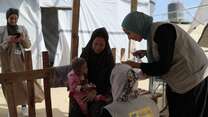The dialogue leading up to the World Humanitarian Summit (May 2016) has cast a spotlight on humanitarian cash transfers. Significant global attention has centered on the role of cash transfers in bringing efficiency to the humanitarian system and improving outcomes for crisis-affected populations. U.N. Secretary-General Ban Ki-moon has called for cash-based programming to be the default method of support for affected populations1, and various high-level panels2 have called for broad scale-up of cash transfers in humanitarian programming. But is it actually possible to safely distribute cash to the millions of people displaced from their homes or impacted by disaster each year across the world?
To realize a global scale-up in cash transfers, countries facing crises must have the necessary infrastructure and financial services in place to make payments safely and efficiently. E-payment3 mechanisms, including mobile-based money transfers and card- based payments such as prepaid debit cards, are effective tools that enable efficient and scalable transfers, improve transparency, and mitigate fraud in humanitarian response. However, these tools are not present in all countries. E-payment tools are increasingly common, but as yet impractical in countries with weak digital and financial infrastructure, regulatory environments, and/ or financial institutions.
Although there has been a substantial increase in donor and private sector interest and investment in digital finance systems worldwide during the past several years, countries or regions most at risk of natural or man-made disasters and where humanitarian organizations tend to respond are often overlooked in these investments.
The objective of this paper is to investigate both the current state of preparedness of e-payment systems to deliver cash transfers in emergency response, and the extent to which existing efforts are actually preparing those e-payment systems to meet the specific e-payment needs of humanitarian agencies.
Understanding e-payment preparedness
Currently, a number of approaches to strengthen e-payment systems exist in developing countries; however, these initiatives are
often uncoordinated. While these efforts focus on similar activities to strengthen e-payments, they aim to achieve different outcomes. Development actors, for example, might focus on strengthening e-payments to achieve financial inclusion or economic growth; humanitarian actors aim to establish rapid and efficient vehicles for delivering aid in emergencies; and private sector actors mainly look to ensure returns on services provided. National and donor governments are invested in each of these outcomes, yet their funding streams are often segmented. In short, there are a number of similar investments and initiatives underway to support e-payments, but no coordinated approach to unify these activities to simultaneously contribute to humanitarian and development outcomes.
This paper analyzes how existing DFS initiatives can better align to support humanitarian response, and uses a framework for comprehensively considering e-payment preparedness. This framework aligns the roles of demand-side (end users, consumers, humanitarian organizations) and supply-side actors (FSPs), and national and donor governments in strengthening e-payment systems. The framework consists of the following three elements:
The preconditions necessary for e-payment preparedness to be feasible. Preconditions are the basic indicators of the readiness of a county’s e-payment ecosystem4 to support cash transfers at scale in emergency response.
The preparedness actions that ensure e-payment use. Preparedness actions identified in the framework focus on those activities specific to facilitating the delivery of e-payments during emergencies.
The actors involved in both preconditions and preparedness activities. Actors represent the demand side and the supply side, the national governments who enable e-payment use in emergencies, and donor governments that fund and facilitate many of the activities.
Applying the e-payment framework: Findings from the field
Six countries were evaluated against the preconditions established under the e-payment preparedness framework to identify their level of readiness for e-payments and the activities needed to strengthen their responsiveness to shocks. The Central African Republic, Pakistan, Nigeria, the Philippines, Somalia, and Yemen were chosen as case studies to represent varying levels of investment in DFS and various types of crises faced.
The country case studies demonstrate a range of readiness and potential for e-payments, but fairly low uptake of e-payments when emergencies strike. Those countries most ready for e-payments have strong infrastructure and electronic Government-to-People (G2P) systems in place. Yet, the cases of Pakistan and the Philippines show that, despite having the infrastructure and systems in place before a crisis occurred, humanitarian actors still struggled to deploy e-payments in emergency settings. That is, having e-payment infrastructure in place is necessary, but not sufficient to effectively scale its use for meeting the needs of disaster-affected households.
Explicit investment to link e-payment infrastructure with the specific needs of emergency response by implementing preparedness measures outlined in the framework is necessary to capitalize on potential e-payment readiness.
Existing support for e-payment preparedness
Additionally, the paper seeks to establish a baseline understanding of how donor support for e-payment preparedness compares to the e-payment preparedness framework. The paper looks at the current state of funding for emergency preparedness activities as well as funding streams commonly associated with financial inclusion or digital finance. Donors examined in the study include DFID, USAID and ECHO, as well as IFC from the World Bank Group and UNCDF. Several trends emerge from the baseline analysis:
For most donors, humanitarian preparedness funding is commonly aligned with resilience funding streams. Although there is significant investment in resilience, specifically in linking humanitarian and development actors to build better prepared communities, no resilience approach explicitly discusses the strengthening of e-payment systems or e-payment preparedness.
Financial inclusion and last-mile connectivity initiatives are expanding e-payments in a number of countries. Significant progress has been made in transitioning G2P payments to e-transfer mechanisms—a key indication of readiness for e-payments at scale in emergencies. However, donor investments in last-mile and G2P initiatives are focused largely on countries less prone to crisis. Resilience-oriented programming, proportionally more directed at disaster-prone contexts, can address this gap, but e-payment investments are not explicitly emphasized in resilience approaches. As a result, countries most likely to require humanitarian assistance and where e-payment systems are most in need to scale-up emergency cash transfers are often those countries with the lowest level of preparedness. Only four of 13 countries currently facing severe humanitarian crisis have digitized G2P programs in place, and only six countries have any initiative underway to extend network connectivity to the last mile.
Conclusions
Current investment in e-payment systems is insufficient to deliver cash transfers at scale during emergency responses in high-risk countries. Although significant work has been done to strengthen e-payments in some regions, particularly more stable countries, funding streams must target countries vulnerable to emergencies with an explicit focus on the e-payment investments required for safe, efficient, and scalable humanitarian cash transfers. To achieve the grand ambition of making cash transfers the default option for humanitarian response, this paper offers four specific insights:
Countries where emergencies are most likely to occur are the least well prepared. Of the 13 countries currently facing severe humanitarian crises according to ACAPS’ GEO5, only four countries (or 31 percent) have a digitized G2P payment program in place and only six countries (or 46 percent) have initiatives underway to achieve last-mile connectivity. A significant geographic re-focusing of DFS investments is needed to ensure the preconditions and infrastructure to deliver e-payments are present and functioning in high-risk countries and areas within those countries. Directing existing resilience or development initiatives to address this gap will strengthen the level of readiness of the most vulnerable countries.
Humanitarian objectives of e-payment system-strengthening initiatives must be made explicit. Strengthening the capacity to meet emergency needs when humanitarian crises arise should be a stated objective of large-scale investments in last-mile connectivity and DFS. Currently, e-payment preparedness for emergency response is mostly a secondary benefit of humanitarian investment and often misses rural, sparsely populated, or particularly poor geographies—the very areas where natural and man-made crises are most likely to occur. Demand for e-payment services from humanitarian actors should be a stated consideration in investment decisions in terms of meeting the volume and logistics of e-payments as well as weighing the potential humanitarian gains from the expansion of services through customer and merchant acquisition.
A single framework strengthens e-payment readiness for humanitarian response. Given the wide range of actors involved in strengthening e-payment systems, it is exceptionally challenging to align priorities, interests, and investments to achieve shared desirable outputs. The e-payment preparedness framework presented in this paper provides a single reference point for understanding what is needed for each actor at each phase of establishing and strengthening e-payment systems, and enables the identification of strategic entry points to build the level of e-payment preparedness in each country. In doing so, the framework highlights the difference between e-payment strengthening writ large and e-payment strengthening specifically for humanitarian response.
Country-specific e-payment preparedness plans are necessary. One size does not fit all in terms of planning for e-payment activities during an emergency response. There is wide variation in the level of development, investment, and preparedness of e-payment systems to deliver emergency cash transfers. The investments required from donors, governments, private sector, and humanitarian actors to strengthen e-payment systems must be tailored to the needs of each country and emergency. The e-payment preparedness framework assists in identifying those priorities.



